Throughout Latin American history, many culture groups have been subjugated to the rule of others. Most notably the indigenous groups. Below are a few examples of the rebellions that occurred throughout Latin America. Generally, the underlying basis of most of these rebellions was ethnicity, racial difference, and the effects of racial superiority. Another important factor in social movements was nationalism and worked on political socialism.
Zapatista Mexican Rebellion:
In 1994, the indigenous of Mexico's southern most states gathered together to rise against the authoritative government. Their main tactic in this battle was to influence people through the use of media, both internet and musicians. The main agendas of this rebellion were democracy, freedom and justice. They were able to gain international attention, however
 |
| A common slogan during this revolution was 'Ya Basta' or 'Enough Already.' |
 |
| The use of a mask was also purposeful, it represents the feigned state of Mexico's affairs. |
Movimiento V Republica (Fifth Republic Movement) (MVR):
This rebellion, which took place in Venezuala, was a left-wing, Socialist political party. It was founded in July 1997, to support the rise of Hugo Chavex, in the 1998 elections. The "Fifth Republic" refers to the fact that in 1997 the then Republic of Venezuela was the fourth in Venezuelan history, and the Movement aimed to re-found the Republic through a constitutional assembly. Following Chávez' 1998 election victory, this took place in 1999, leading to the 1999 Constitution of Venezuela.
 |
| Political flag of the MVR party |
 |
| Hugo Chavez, leader of MVR |
Movimento dos Trabalhadores Sem Terra (Landless Workers' Movement) (MST):
Regarded a one of the largest social movements in Latin America, MST had an estimated 1.5 million participants. The MST's goal was to make people aware of unjust land distribution, and help farmers realize their civil rights. They demanded the restoration of a social contract that provided a more sustainable way of life for the farmers and rural inhabitants.
 |
| Protesters in Brazil |
 |
| MST emblem |
Cuban Revolution (26th of July Movement):
The Cuban Revolution was an armed revolt by Fidel Castro's 26th of July Movement against the regime of Batista, the Cuban dictator. The revolution lasted for a few years, beginning in 1953 and finally replacing the regime in 1959.
 |
| 26th of July Movement Flag |
 |
| Fidel Castro and his army |
Bolivian National Revolution:
The Revolutionary Nationalist Movement (MNR) was a middle class coalition that emerged in 1941, after the Chaco War. The party promoted Marxism as a better fit for Bolivia's culture than a nationalist ideology. In 1952, the MNR led a revolt against the oligarchy Partido Izquierda Revoluncionario (PIR). They were successful, and under the leadership of President Victor Estenssoro and Hernan Siles, they introduced universal suffrage, land reforms, rural education, and nationalized tin mines. They were also one of the first countries to take into account the indigenous populations and their needs.
 |
| Bolivian Revolutionaries |
 |
| MNR emblem |
Mexican Revolution:
One of the earliest Latin American social revolutions occured in Mexico. It began in 1910 and lasted for approximately 10 years. This revolution led to the creation of the Institutional Revolutionary Party, or the PRI, a party that held power until the year 2000. The main reforms that this revolution fought for was agricultural reforms as well as other political and economic freedoms. Emiliano Zapata, the main leader of this revolution, is still well revered among the Mexicans. The revolution ended in 1920 with general elections.
 |
| Emiliano Zapata |
.svg/300px-PRI_Party_(Mexico).svg.png) |
| PRI Party Symbol |










.svg/300px-PRI_Party_(Mexico).svg.png)
No comments:
Post a Comment